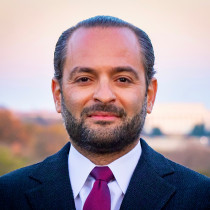Contents:
- "Day after" Gaza war planning underway as conflict drags on
- With Israeli war cabinet dissolved, Netanyahu and his confidants take center stage
- US diplomacy races to stave off a major Israel-Hezbollah war
- As Sudan’s refugee crisis deepens, mutual aid groups save lives
“Day after” Gaza war planning underway as conflict drags on
Brian Katulis
Senior Fellow for US Foreign Policy

-
The Biden administration has not achieved a cease-fire in Gaza more than two weeks after President Joe Biden released his three-phase plan.
-
The ongoing conflict has not prevented the start of discussion and planning about what the “day after” might look like, even as the two main combatants remain opposed to the long-term objective of a two-state solution.
The war between Israel and Hamas continues in Gaza more than two weeks after President Joe Biden released a three-phase plan for achieving a cease-fire and using that end to hostilities as a foundation for a longer-term resolution of the conflict. Hamas reportedly proposed changes to the cease-fire plan that Biden presented at the end of last month, and US Secretary of State Antony Blinken last week deemed several of them to be “unworkable.”
The lack of results in producing a cease-fire linked to a hostage release and Palestinian prisoner exchange has not stopped the Biden administration and some outside analysts from imagining what the day after the conflict ends might look like: that is, who will maintain security and lead governance efforts in the Gaza Strip and how those plans can contribute to building a bridge between the immediate cease-fire period and a longer-term effort to resolve the conflict. A recent article by Nahal Toosi in Politico offers an overview of some of the “day after” plans that have been made public by various think tanks. And there are several private efforts both inside and outside of governments to imagine what the future might look like once this war is done.
In a valuable contribution to this overall effort, Larry Garber, a former senior policy official at the United States Agency for International Development (USAID) during the Clinton and Obama administrations who also served as the USAID mission director to the West Bank and Gaza, has written an analytical framework for evaluating all of the plans on the post-war situation in Gaza as they emerge. Many of the key questions to ask about the various post-war plans, which he raises in his piece, are centered on issues of political legitimacy and ways to ensure that the Palestinian people have a voice in the decision-making processes that are established after the war is over.
No plan for the post-war period will be relevant until the two main combatants to this conflict, Israel and Hamas, make the decision to put down their arms and pursue a diplomatic pathway, which the Biden administration and other actors have been trying to construct as the war ensues. The way this war ends also will determine who has the power to shape outcomes in any post-war scenario for Gaza. The fact of the matter is that technocratic planning exercises are unlikely to provide much beyond a general framework until the balance of power among the political forces on the ground is clarified by this conflict and how it ends.
Predicting who will have the upper hand when the war is over is like trying to estimate the damage done by a category five hurricane while it’s still battering the shore. Nevertheless, these exercises in trying to conceptualize and imagine an alternative post-war future are important because they can help provide a vision that incentivizes actions to reach stability and prosperity in the long run.
Increased American engagement in the Middle East, particularly stepped-up US involvement and support for Palestinian self-determination leading to the creation of a Palestinian state, is necessary for any of these post-war plans to succeed in providing long-term stability and peace. This means that those calling for US disengagement from the Middle East, including the neo-isolationist voices in broader American foreign policy debates, aren’t offering a practical plan for ending the Israel-Hamas war in a way that leads to lasting outcomes.
Post-war planning efforts can help offer a template for policy, but that template will need to be adapted according to the balance of power that exists within Palestinian and Israeli politics after this war ends.
Follow: @Katulis
With Israeli war cabinet dissolved, Netanyahu and his confidants take center stage
Nimrod Goren
Senior Fellow for Israeli Affairs

-
Eight months after it was established, in the aftermath of Oct. 7, Israeli Prime Minister Benjamin Netanyahu has dissolved the war cabinet, following the resignation of Benny Gantz’s centrist party from the unity government.
-
This decision will not have a dramatic impact on Israel’s war-related policies, but the reversion to the pre-war governing status quo will highlight the centrality of Netanyahu and his confidants in decision-making, at a time when many Israelis seek a change of leadership.
The establishment of the Israeli war cabinet on Oct. 11, 2023, was a political solution to a radically new situation. Following the Oct. 7 Hamas terror attack, the centrist National Unity party, led by Benny Gantz, joined Prime Minister Benjamin Netanyahu’s far-right coalition. But the continued presence in the government of extremist Ministers Itamar Ben-Gvir and Bezalel Smotrich blocked the entry of additional parties into the emergency coalition, chief among them Yair Lapid’s Yesh Atid party.
As a way to legitimize Gantz’s decision to join, and to create a decision-making mechanism separate from the extremists, an ad hoc war cabinet was formed, in parallel to the statutory “regular” cabinet that continued operating. There was no clear division of labor between the two decision-making bodies, and that enabled Netanyahu to juggle between them to best advance his political interests.
The war cabinet was supposedly the serious and responsible mechanism, where national security considerations topped the agenda. Whereas the regular cabinet was where ministers would jockey to generate headlines, for example by attacking generals for being too soft or by leaking information and statements to the media.
The existence of a war cabinet in which two respected former Israel Defense Forces (IDF) chiefs of staff – Gantz and Gadi Eisenkot – were members served as a reassurance for the Israeli public, amid an unprecedented crisis. But with time, this special cabinet increasingly became a façade of responsible wartime management and an enabler for the prime minister. Netanyahu was advancing his own will, while sidelining and sometimes even bashing his centrist coalition partners in the unity government.
Once Gantz made his political move and withdrew his party from the coalition, there seemed to be no reason for the war cabinet to remain in place — even less so with Ben-Gvir and Smotrich demanding to join it. Dissolving the cabinet thus became Netanyahu’s solution to a new political reality.
With the war cabinet disbanded, it is unlikely that Israel’s war-related policies will drastically change. Netanyahu will probably rely more on his two closest confidants — National Security Advisor Tzachi Hanegbi and Minister of Strategic Affairs Ron Dermer. The pair is already expected to visit Washington, DC, for a strategic dialogue next week. Minister of Defense Yoav Gallant is also set to arrive in Washington later this month and may well be the preferred official interlocutor for the Biden administration now that Gantz is no longer in the government.
While Gallant is somewhat of a political rival to Netanyahu within the Likud party, the two do not differ much when it comes to preferences related to Gaza and Lebanon. On the other hand, Gallant is pushing for a clearer and more moderate “day after” plan for Gaza, and he objects to legislative efforts that will broadly exempt the ultra-Orthodox community from military service; on these issues, he and Netanyahu are at odds. The way in which the dynamic between them evolves will be decisive for the future stability of the Israeli government, particularly at a time when many Israelis seek a change of leadership.
Follow: @GorenNimrod
US diplomacy races to stave off a major Israel-Hezbollah war
Firas Maksad
Senior Director for Strategic Outreach and Senior Fellow

-
Neither Israel nor Hezbollah wants to stumble into a devastating conflict that could quickly escalate into a region-wide conflagration; but paradoxically, because both are aware that the other side hopes to avoid war, each is seeking to take advantage, pushing the envelope further in the hope of establishing escalation dominance.
-
The Israeli military and even Prime Minister Benjamin Netanyahu’s traditional detractors on the left are, in fact, to his right on the issue; and if US special envoy Amos Hochstein’s diplomacy cannot halt Hezbollah’s rocket fire, Netanyahu may feel compelled to undertake a major military operation deep into Lebanese territory.
Israel’s successful elimination of a top Hezbollah commander on June 11 and the Lebanese militant group’s firing of hundreds of missiles into northern Israel in response have brought the two closer to an all-out war than at any time since current hostilities erupted on Oct. 8, 2023. The stakes could not be higher, with Iran messaging that it would come to the defense of its most valuable proxy should Israel launch a broader campaign against it. For its part, although actively engaged in trying to contain the conflict, the Biden administration has committed to Israel’s defense should it find itself in a major armed confrontation on the northern front. As such, the stage is currently set for an Israel-Hezbollah war that could quickly escalate into a region-wide conflagration.
Special envoy Amos Hochstein, a top aide to US President Joseph Biden, is in Israel and Lebanon this week on a critical mission to defuse the crisis. Paradoxically, neither of the immediate belligerents (nor their backers) has an interest in stumbling into such a devastating conflict. Yet in a classic game of chicken, it is precisely because both are aware that the other side hopes to avoid war that each is seeking to take advantage, pushing the envelope further in the hope of establishing escalation dominance.
To date, Hezbollah has taken comfort from Israel’s reluctance to fight on two fronts and from the Biden administration’s vocal opposition to Israel launching a war in Lebanon. Furthermore, Hezbollah officials stress that a major war is unlikely to offer Israel the objective it seeks: a return of some 100,000 Israelis to their northern communities. Instead, destruction will dominate the landscape on both sides of the border.
Hezbollah, however, is misreading the domestic political landscape in Israel. The Israeli military, and even Prime Minister Benjamin Netanyahu’s traditional detractors on the left, are in fact to his right on the issue of settling scores with Hezbollah.
In the coming days, should Hochstein fail to stem Hezbollah’s rocket fire through diplomacy, Netanyahu could feel compelled to undertake a major military operation in the north, culminating in the creation of a de-facto buffer zone 10-15 kilometers deep into Lebanese territory.
Netanyahu may bet that Hezbollah would ultimately keep the fight limited to the border and away from major Israeli population centers, so as to avoid the destruction of Beirut. This would be a perilous assumption at best, and both sides are better served taking the diplomatic off-ramp offered by Hochstein, even if a full cessation of hostilities will have to wait for a still elusive cease-fire in Gaza.
Follow: @FirasMaksad
As Sudan’s refugee crisis deepens, mutual aid groups save lives
Jehanne Henry
Non-Resident Scholar

-
Over 10 million Sudanese are internally displaced, and 2 million have fled to neighboring countries and beyond in what has been called the world’s largest internal displacement crisis, the leading humanitarian crisis, and among the worst refugee crises currently unfolding across the globe.
-
If there is a ray of hope, local mutual aid groups and volunteers across Sudan have provided life-saving support, running local clinics, kitchens, and shelters, even as the warring parties have restricted, diverted, or confiscated aid.
Now 14 months into the war between the Sudanese Armed Forces (SAF) and the paramilitary Rapid Support Forces (RSF), Sudan has been called the world’s largest internal displacement crisis, the leading humanitarian crisis, and among the worst refugee crises currently unfolding across the globe. Over 10 million are internally displaced, and 2 million have fled to neighboring countries and beyond. According to a data visualization map produced by the United Nations last April, this Sudanese exodus spans the region from Chad to Saudi Arabia, Uganda to Malta.
These figures will keep rising as long as the war continues. As the two sides and their allies continue to fight in hotspots like Darfur, Khartoum, and Gezira for control over territory, more people are forced to leave their homes. Even in the so-called safer zones — whether under RSF or SAF control — living conditions have dramatically deteriorated. The lack of basic services, worsening communications, disruptions to farming and markets, mounting inflation, and, in some places, famine, are all forcing people to leave.
Far from a simple power struggle between two generals, the SAF’s Abdel Fattah al-Burhan and the RSF’s Mohamed Hamdan Dagalo (aka “Hemedti”), the war has morphed into much more. The fighting has increasingly played on other divisions in Sudanese society, drawing in other actors. Once-neutral rebel groups in Darfur have entered the fray, raising the specter of more ethnic-based violence. New militia groups, including Islamist ones, have attracted youth, mercenaries, and ideologues.
In this hyper-polarized context, local authorities view any form of political activism in their controlled territories — including “no to war” demonstrations — and even humanitarian actors, with suspicion; both the SAF and RSF have detained volunteers, accused of spying for the other side. The war has also divided civil society. One-time allies against former President Omar al-Bashir’s regime are now opponents, as some support the SAF despite its Islamist links, while others back the new civilian front known as “Taqaddum” (or “progress,” an acronym for the Coordination of Civil Democratic Forces) despite the latter’s failure to denounce the RSF’s horrific abuses against civilians, including genocide in Darfur.
If there is a ray of hope, it is the Sudanese spirit of volunteerism. Across the country, as the warring parties restricted, diverted, or confiscated aid, awe-inspiring local mutual aid groups and volunteers have provided life-saving support, running local clinics, kitchens, and shelters. To many, these volunteers stand as proof that no matter what the warring parties do to the country, they cannot crush the spirit of community solidarity. As one volunteer wrote one year into the war, “the Sudanese people are resilient and […] determined to foster peace and reconciliation amid a war with no end in sight.”
Follow: @jehannehenry
Photo by BRENDAN SMIALOWSKI/AFP via Getty Images
The Middle East Institute (MEI) is an independent, non-partisan, non-for-profit, educational organization. It does not engage in advocacy and its scholars’ opinions are their own. MEI welcomes financial donations, but retains sole editorial control over its work and its publications reflect only the authors’ views. For a listing of MEI donors, please click here.













